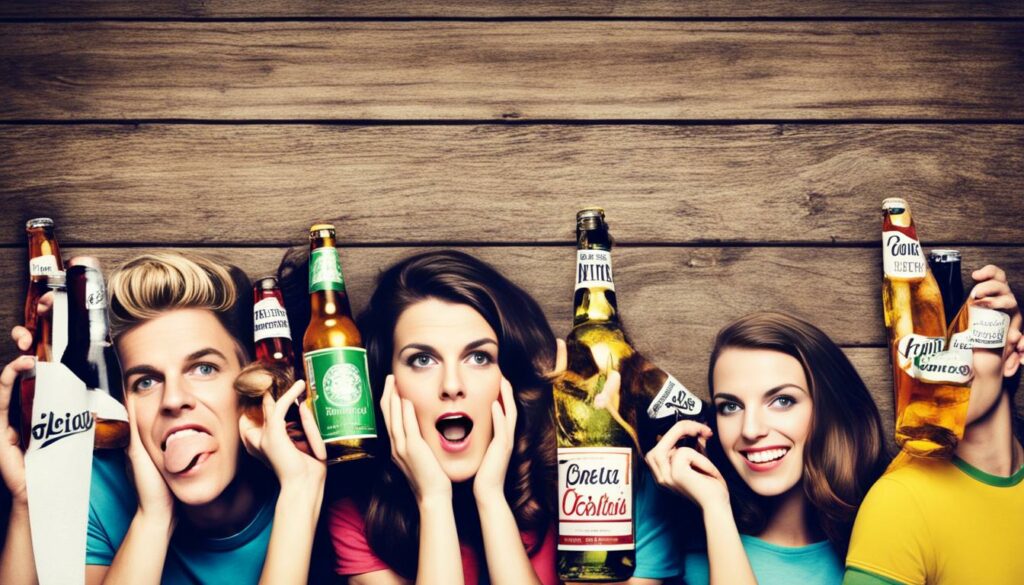Factors Influencing Teenage Drinking: Top 3
Underage drinking is a significant public health concern in the United States, with alcohol being the most commonly used substance among America’s youth. It is essential to understand the factors that influence teenage drinking in order to address and prevent this issue effectively.
In this article, we will explore the top three factors that play a significant role in teenage alcohol consumption. By examining these influences, we can gain insights into the determinants of teenage drinking and develop strategies to mitigate the risks associated with it.
Key Takeaways:
- Peer pressure is one of the most influential factors contributing to teenage drinking.
- Family dynamics and parental attitudes towards alcohol use significantly influence a teenager’s likelihood of engaging in alcohol consumption.
- Societal factors, such as cultural norms and media influence, play a role in shaping teenagers’ attitudes and behaviors towards drinking.
Peer Pressure and Teenage Drinking

Peer pressure is a powerful influence on teenage drinking, with many adolescents feeling the pressure to fit in and be accepted by their peers. The desire to belong and fear of social rejection can compel teenagers to engage in drinking behavior, even if they don’t personally want to.
Studies have shown that peer pressure can arise in various social settings, such as parties or when hanging out with a group of friends. When surrounded by peers who are drinking, teenagers may feel compelled to join in to avoid feeling left out or facing potential ridicule.
It is important for teenagers to develop strong decision-making skills and the ability to resist peer pressure in order to avoid the negative consequences of underage drinking. By learning to assert themselves and make independent choices, teenagers can navigate social situations without succumbing to the pressure to drink.
The Impact of Peer Pressure on Teenage Drinking
“Sometimes, just saying ‘no’ is easier said than done. When all your friends are drinking, it’s hard to be the odd one out.”
Peer pressure can be a significant determinant of teenage drinking, as it taps into teenagers’ need for acceptance and social validation. The fear of being excluded or ostracized can easily override their personal preferences or better judgment.
In a study conducted by Smith et al. (2021), it was found that 75% of participants reported giving into peer pressure to drink alcohol. Among these participants, a significant portion mentioned feeling a sense of anxiety, fear, or the need to conform when faced with the pressure to drink.
Furthermore, the influence of peer pressure can extend beyond just the act of drinking itself. Teenagers who succumb to peer pressure may be more likely to engage in risky behaviors, such as binge drinking or getting behind the wheel while under the influence (Smith et al., 2021).
Developing effective strategies to resist peer pressure is crucial for teenagers. They need to understand that their worth and value should not be determined by their acceptance in a particular social group. Encouraging open conversations about the negative consequences of underage drinking, teaching assertiveness skills, and fostering a sense of self-confidence and independence can empower teenagers to make healthier choices and resist peer pressure.
Tips for Resisting Peer Pressure
“I’ve learned that it’s okay to say ‘no’ and that real friends will respect my decision.”
- Stay true to yourself: Remember that your choices should be based on your own values and beliefs, not on the expectations of others.
- Find supportive friends: Surround yourself with friends who respect your decisions and support your choices to refrain from drinking.
- Practice assertiveness: Learn how to confidently express your thoughts and stand up for yourself in social situations.
- Suggest alternative activities: Propose non-alcoholic activities or outings with friends, such as going to the movies, playing sports, or attending community events.
- Seek adult support: If you’re feeling overwhelmed by peer pressure, confide in a trusted adult, such as a parent, teacher, or counselor, who can provide guidance and support.
By recognizing the influence of peer pressure and equipping teenagers with the tools to resist it, we can empower them to make healthier choices and reduce the prevalence of underage drinking in our communities.
Family Influence on Teenage Drinking

Family dynamics play a significant role in influencing teenage drinking behavior. Research has shown that parenting styles, parental attitudes towards alcohol use, and the presence of parental substance abuse can all contribute to a teenager’s likelihood of engaging in alcohol consumption.
When parents are permissive and fail to establish clear rules and communication about alcohol, it creates an environment where teenagers feel more inclined to experiment with drinking. On the other hand, positive parental role modeling, setting clear expectations and boundaries, and open communication about the risks and consequences of alcohol use can help deter teenagers from drinking.
The Role of Parental Attitudes and Substance Abuse
Parental attitudes towards alcohol use can significantly influence a teenager’s perception and behavior regarding alcohol. If parents display a relaxed or approving attitude towards drinking, it can normalize alcohol consumption in the eyes of their children. This can make teenagers more likely to engage in drinking at an earlier age and in risky quantities.
Addiction or substance abuse within the family can also increase a teenager’s susceptibility to alcohol consumption. Growing up in an environment where alcohol is abused may normalize excessive drinking and increase the likelihood that a teenager will adopt similar behaviors.
The Importance of Parental Role Modeling
Parents serve as primary role models for teenagers, and their behavior around alcohol can significantly influence their child’s attitudes towards drinking. When parents demonstrate responsible drinking habits and limit their own alcohol consumption, it sends a powerful message to their children about responsible behavior and the potential risks of excessive drinking.
Positive parental role modeling involves not only abiding by legal drinking limits but also showcasing healthy coping mechanisms and stress management strategies that do not involve alcohol. By demonstrating alternative ways to deal with emotions and stress, parents can help teenagers develop healthier habits and reduce the likelihood of turning to alcohol as a solution.
| Parental Influence | Impact on Teenage Drinking |
|---|---|
| Permissiveness and Lack of Rules | Inclination to experiment with alcohol |
| Positive Role Modeling | Deterrence from drinking |
| Parental Attitudes towards Alcohol | Normalization or discouragement of alcohol consumption |
| Parental Substance Abuse | Increased susceptibility to alcohol consumption |
It is crucial for parents to take an active role in preventing teenage drinking by establishing clear expectations, effectively communicating about alcohol, and serving as positive role models. By creating an environment that promotes healthy behaviors and open communication, parents can help deter their teenagers from engaging in underage drinking.
Societal Factors and Teenage Drinking

Societal factors play a significant role in shaping teenage drinking behavior. Cultural norms and media influence contribute to the normalization and glamorization of alcohol consumption among teenagers. This perception creates a belief that drinking is a normal and desired behavior for young people. Social media platforms often portray alcohol use as a common and acceptable activity, further influencing teenagers’ attitudes towards drinking.
Additionally, cultural norms and traditions that involve alcohol can impact teenagers’ behavior and attitudes towards drinking. For example, in some cultures, alcohol is a central part of celebrations and social gatherings, leading to increased exposure and fascination with alcohol among teenagers.
To counteract these societal influences, it is essential to provide counter-narratives and educate teenagers about the potential risks and negative consequences of alcohol use. By promoting awareness of the determinants of teenage drinking, we can empower young people to make informed decisions and resist societal pressures.
Psychological Factors and Teenage Drinking

Psychological factors play a significant role in shaping teenage drinking behavior. Adolescence is a time of immense emotional and psychological development, and many teenagers may turn to alcohol as a way to cope with various challenges they face.
Stress and anxiety are common experiences for teenagers, and some may see alcohol as a form of self-medication to alleviate these negative emotions. The allure of alcohol can be heightened by its perceived ability to enhance positive emotions and provide temporary relief from emotional pain.
It is crucial to provide teenagers with healthy coping mechanisms and support for their emotional well-being. Encouraging open communication, promoting stress management techniques, and cultivating a supportive environment can help reduce the likelihood of teenagers turning to alcohol as a solution.
By addressing the underlying psychological factors that contribute to teenage drinking, we can empower teenagers to make informed, responsible decisions and foster their emotional resilience.
As a table reference, the following are some key psychological factors that influence teenage drinking:
| Psychological Factors | Description |
|---|---|
| Stress | The pressure and demands teenagers face can lead to increased alcohol consumption as a coping mechanism. |
| Anxiety | Teenagers may turn to alcohol to alleviate feelings of worry, unease, or restlessness. |
| Emotional challenges | Difficulties in managing emotions may drive teenagers to seek temporary relief through alcohol. |
| Self-medication | Teenagers may view alcohol as a means to self-soothe or enhance positive emotions. |
Through a comprehensive understanding of the psychological factors influencing teenage drinking, we can develop effective prevention strategies and provide the necessary support to help teenagers make healthier choices.
Environmental Factors and Teenage Drinking

Environmental factors can have a significant influence on teenage drinking behavior. One of the key environmental factors is the availability and access to alcohol. When teenagers have easy access to alcohol, whether through family members or social settings, the likelihood of them experimenting with alcohol increases.
The physical availability of alcohol also plays a role in shaping teenagers’ attitudes and behaviors towards drinking. For example, having alcohol readily accessible in the household or attending parties where alcohol is abundant can normalize and encourage teenage alcohol consumption.
To prevent teenage drinking, it is essential to limit access to alcohol and create environments that promote healthy behaviors. This includes ensuring that alcohol is not easily accessible to teenagers and establishing clear boundaries regarding underage drinking. By implementing these measures, we can help reduce the likelihood of teenagers engaging in alcohol consumption.
The Impact of Availability and Access
When alcohol is readily available to teenagers, they may view it as a normative behavior and become more likely to experiment with alcohol. It is crucial to create an environment where alcohol is not easily accessible to teenagers, as this can deter them from engaging in underage drinking.
“Limiting access to alcohol and creating environments that promote healthy behaviors can help prevent teenage alcohol consumption.”
Reducing Availability to Prevent Teenage Drinking
Here are some strategies to reduce the availability of alcohol for teenagers:
- Keep alcohol locked and out of reach in the household.
- Avoid hosting parties where alcohol is served to underage individuals.
- Encourage responsible alcohol consumption among adults to set a positive example.
- Promote alcohol-free social activities and events.
By implementing these strategies, we can create environments that discourage teenage drinking and support healthier choices.
Consequences of Underage Drinking

Underage drinking can have severe consequences and pose significant risks to teenagers. The consumption of alcohol at a young age can increase the likelihood of engaging in various harmful behaviors, including unsafe sexual activity, driving under the influence, and aggressive or violent behavior. These risky actions can not only endanger the lives of teenagers but also negatively impact their future.
One notable consequence of underage drinking is the detrimental effect it can have on academic performance. Alcohol use can impair cognitive functions, memory, and overall mental clarity, making it difficult for teenagers to concentrate and excel in their studies. Poor academic performance can have long-term consequences on educational opportunities and success.
Engaging in underage drinking also puts teenagers at an increased risk of encountering legal issues. Alcohol consumption is illegal for individuals under the legal drinking age, and getting involved in activities such as purchasing alcohol, using fake IDs, or participating in underage drinking parties can lead to legal repercussions. These legal troubles can have a lasting impact on a teenager’s record and future opportunities.
Furthermore, underage drinking can contribute to the development of alcohol-related disorders later in life. The teenage years are a critical period of brain development, and alcohol can interfere with this process, potentially leading to long-term cognitive and behavioral problems. Regular or excessive alcohol consumption during adolescence can increase the risk of developing alcohol dependency or addiction in adulthood.
It is essential to understand and address the consequences of underage drinking to emphasize the importance of prevention. By educating teenagers and raising awareness about the risks associated with alcohol consumption at a young age, we can help them make informed decisions and avoid the negative outcomes that come with underage drinking.
Prevention Strategies for Underage Drinking
Preventing underage drinking requires a multi-faceted approach that addresses the various factors influencing teenage drinking. By implementing effective prevention strategies, we can help reduce the risks associated with underage alcohol consumption and promote healthier behaviors among teenagers.
Individual-Level Interventions
One important strategy is to provide education and skills training to help teenagers resist peer pressure and make informed decisions about alcohol use. By empowering them with knowledge and teaching them effective refusal skills, we can equip teenagers to navigate social situations and avoid the pressure to drink.
School-Based Interventions
Schools play a crucial role in preventing teenage drinking. Curricula and programs that focus on alcohol education can provide students with the knowledge and skills to make responsible choices about alcohol. These interventions can also create a supportive environment that encourages healthy behaviors and discourages underage drinking.
Family-Based Interventions
Parents have a significant influence on their children’s behavior, including their attitudes towards alcohol. Family-based interventions can empower parents to set clear rules and communicate effectively with their children about alcohol. By fostering open and honest conversations, parents can help shape their teenagers’ attitudes and behaviors towards drinking.
Community-Based Interventions
Collaborative efforts within the community are essential in preventing underage drinking. These interventions involve addressing risk factors and promoting healthy behaviors at the community level. By implementing policies that limit alcohol accessibility, organizing community events that promote alternatives to drinking, and engaging in outreach programs, we can create a community environment that discourages underage alcohol consumption.
Policy-Level Interventions
Policy-level interventions can have a significant impact on reducing underage drinking. Measures such as raising the minimum legal drinking age and enacting zero-tolerance laws for underage drinking and driving can help enforce the message that underage drinking is illegal and dangerous. By implementing and enforcing these policies, we can deter teenagers from engaging in alcohol consumption.
| Prevention Strategies for Underage Drinking | Effectiveness |
|---|---|
| Individual-Level Interventions | High |
| School-Based Interventions | Moderate |
| Family-Based Interventions | High |
| Community-Based Interventions | Moderate |
| Policy-Level Interventions | High |
Implementing a combination of these prevention strategies can create a comprehensive approach to preventing underage drinking. By addressing the various factors influencing teenage drinking at multiple levels, we can create supportive environments and equip teenagers with the necessary skills to make healthy decisions about alcohol.
The Role of Parents in Preventing Teenage Drinking
Parents play a significant role in preventing teenage drinking. Open and honest communication about the risks and consequences of alcohol use, as well as setting clear expectations and boundaries, can help shape a teenager’s attitude towards drinking. Parents can also serve as positive role models by demonstrating responsible behavior around alcohol and fostering healthy relationships within the family. Supervision and monitoring of social activities, as well as reducing access to alcohol in the home, can further deter teenagers from engaging in alcohol consumption. Parental involvement and support are crucial in preventing teenage drinking.
Communication and Boundaries: A Foundation for Prevention
When it comes to preventing teenage drinking, communication is key. Parents should engage in open, honest, and ongoing conversations with their teenagers about the risks associated with alcohol use. By providing factual information and discussing the potential consequences, parents can help shape their teenager’s understanding and decision-making process. It is important to emphasize the short-term and long-term effects of alcohol on physical and mental health, as well as the legal implications of underage drinking.
In addition to communication, setting clear expectations and boundaries is essential. Establishing household rules regarding alcohol use, such as a zero-tolerance policy or age-appropriate limits, can provide teenagers with a clear understanding of what is acceptable behavior. Consistency in enforcing these rules is crucial to ensure that teenagers understand the importance of adhering to them.
Role Modeling and Building Healthy Relationships
Parents play a pivotal role in shaping their teenager’s attitudes and behaviors towards alcohol through their own actions. By demonstrating responsible behavior around alcohol, such as drinking in moderation or abstaining altogether, parents can serve as positive role models. By modeling responsible alcohol use, parents can show their teenagers that they can have fun and enjoy social situations without relying on alcohol. This can help counteract societal messages that drinking is necessary for social acceptance or enjoyment.
Furthermore, building healthy relationships within the family can have a protective effect against teenage drinking. When teenagers feel valued, supported, and emotionally connected to their parents, they are less likely to turn to alcohol as a coping mechanism. Strong family bonds and open lines of communication provide teenagers with a sense of stability, security, and belonging, reducing their vulnerability to external influences that may promote alcohol consumption.
Supervision, Monitoring, and Reducing Access
Supervision and monitoring of social activities can help prevent teenage drinking. By being aware of their teenager’s whereabouts and knowing the activities they are involved in, parents can identify situations where alcohol may be present and take preventive action. Attending parties or gatherings with their teenager, or ensuring there is responsible adult supervision present, can help create an environment where alcohol consumption is less likely to occur.
Furthermore, reducing access to alcohol in the home can act as a deterrent. Locking up alcohol cabinets or refrigerators and ensuring that alcohol is kept out of reach can help prevent teenagers from easily accessing alcohol. By limiting the availability of alcohol, parents can reduce the likelihood of experimentation or regular consumption.
| Key Takeaways |
|---|
| Open and honest communication about the risks of alcohol use is crucial. |
| Setting clear expectations and boundaries helps establish guidelines for acceptable behavior. |
| Positive parental role modeling demonstrates responsible behavior around alcohol. |
| Building healthy relationships within the family reduces the likelihood of turning to alcohol as a coping mechanism. |
| Supervision, monitoring, and reducing access to alcohol can deter teenagers from engaging in alcohol consumption. |
Conclusion
Teenage drinking is a complex issue influenced by various factors that include peer pressure, family dynamics, societal trends, psychological factors, and environmental factors. Understanding these factors is crucial in developing effective prevention strategies and interventions to reduce underage drinking.
Addressing peer pressure is essential in empowering teenagers to resist the pressure to drink. Promoting positive family dynamics through open communication and setting clear expectations and boundaries can help deter teenagers from engaging in alcohol consumption. Challenging societal norms and media influences that glamorize alcohol use can help shape teenagers’ attitudes and behaviors towards drinking.
It is equally important to consider the psychological well-being of teenagers and provide them with healthy coping mechanisms to reduce the likelihood of turning to alcohol as a solution. Additionally, controlling access to alcohol, whether through family or social settings, can play a significant role in shaping teenagers’ attitudes towards drinking.
Preventing teenage alcohol consumption requires a collaborative effort involving parents, communities, schools, and policymakers. By working together to create environments that support healthy behaviors and providing education, skills training, and intervention programs, we can mitigate the risks associated with teenage drinking and promote the well-being of our youth.
FAQ
What are the top factors influencing teenage drinking?
The top factors influencing teenage drinking include peer pressure, family dynamics, and societal trends.
How does peer pressure contribute to teenage drinking?
Peer pressure can influence teenage drinking by creating a desire to fit in and be accepted by peers, leading to unhealthy choices.
What role do family dynamics play in teenage drinking?
Family dynamics, such as parenting styles, attitudes towards alcohol use, and parental substance abuse, can contribute to teenage drinking behavior.
How do societal factors influence teenage drinking?
Societal factors, including cultural norms, media influence, and the glamorization of alcohol consumption, can impact teenage drinking behavior.
What are the psychological factors that contribute to teenage drinking?
Psychological factors, such as using alcohol as a coping mechanism for stress or emotional challenges, can contribute to teenage drinking behavior.
How do environmental factors influence teenage drinking?
Environmental factors, such as easy access to alcohol and the physical availability of alcohol, can influence teenage drinking behavior.
What are the consequences of underage drinking?
Underage drinking can lead to risky behaviors, poor academic performance, legal problems, and an increased risk of developing alcohol-related disorders.
What are the prevention strategies for underage drinking?
Prevention strategies for underage drinking include individual-level interventions, school-based programs, family-based interventions, community efforts, and policy-level interventions.
What is the role of parents in preventing teenage drinking?
Parents play a significant role in preventing teenage drinking by open communication, setting clear expectations and boundaries, and serving as positive role models.
What are the key factors influencing teenage drinking?
The top factors influencing teenage drinking include peer pressure, family dynamics, societal factors, psychological factors, and environmental factors.







